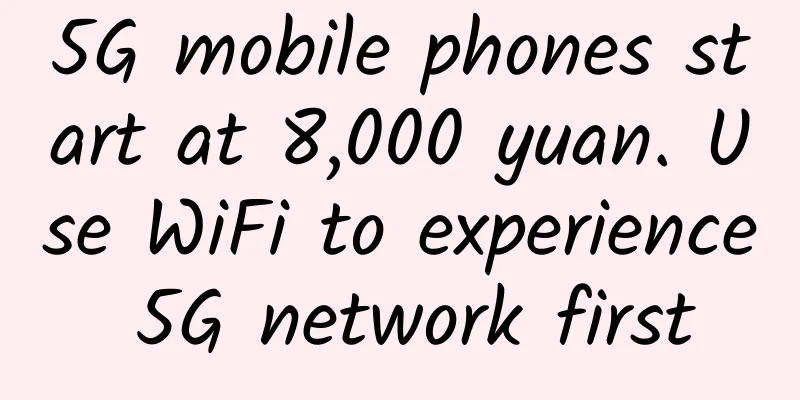The three kings of wireless communications, who can manage tens of billions of IoT devices?

|
According to the "2018-2023 China Internet of Things Industry Segment Market Demand and Investment Opportunity Analysis Report" released by the Forward-looking Industry Research Institute, the number of global Internet of Things devices reached 8.4 billion in 2017, an increase of 31% from 6.4 billion in 2016. It is expected that the number of Internet of Things devices will reach 20.4 billion by 2020. Just imagine that there will soon be 20.4 billion IoT devices in the world, which is 2.7 times the global population. There are more than 7,000 languages used in communication between people, which creates many barriers. What about real-time communication between tens of billions of IoT devices? This is a huge challenge to existing communication technologies. Behind the explosive growth in numbers, the three major wireless connection technologies, Wi-Fi, Bluetooth, and Zigbee, are competing for supremacy. Today, this article compares the three technologies in detail to analyze their advantages and disadvantages in specific application scenarios.
Bluetooth: low power consumption, low cost, and a wide range of compatible devices Bluetooth is a short-range wireless communication technology that enables short-range data connections between fixed and mobile devices. For example, Bluetooth technology can transmit information wirelessly between mobile phones, tablet computers, laptops and other devices. In actual applications, smart devices can also be connected to smartphones through the Bluetooth protocol, and the device status can be checked through the phone. The popularity of Bluetooth technology on the consumer side is already quite high. At present, Bluetooth technology has been upgraded to version 5.0, which not only supports one-to-one connection of devices, but also supports one-to-many connection in star topology. In other words, a mobile phone can connect to a large number of Bluetooth devices and control them. Bluetooth technology has the advantages of low power consumption, low cost, fast network configuration, strong stability and high security. The upper limit of transmission speed is 24Mbps, the effective transmission distance can reach 20-300 meters, and network configuration only takes 3 milliseconds. In terms of information security, Bluetooth provides two layers of password protection, and the security reaches the level of US federal security regulations. Wi-Fi: Widespread application and high transmission rate Wi-Fi, commonly known as wireless broadband, belongs to WLAN wireless local area network and supports simultaneous transmission of multiple terminal devices, that is, one-to-many connection mode. It is understood that the Wi-Fi Alliance plans to launch the Wi-Fi 6 certification program this fall. By then, the transmission distance and connection efficiency will be further improved. Wi-Fi has a high transmission rate and a transmission distance of 20-200 meters, which can meet daily office needs. In addition, Wi-Fi is one of the most popular wireless connection technologies. Mobile phones, computers and other digital products all include Wi-Fi technology as a mainstream standard configuration. However, Wi-Fi technology has poor security, high power consumption, and relatively weak networking capabilities, which limits its development in the smart home field. Zigbee: low power consumption and flexible operating frequency band Zigbee, also known as Purple Bee, is a low-speed, short-distance transmission wireless network protocol with the advantages of low power consumption, large network capacity, and flexible operating frequency bands. Among them, the flexibility of the working frequency band is the biggest advantage of Zigbee compared with other wireless connection technologies. It can work on three frequency bands: 2.4GHz (universal worldwide), 868MHz (universal in Europe) and 915 MHz (universal in the United States). In addition, since the self-organizing function of Zigbee allows each node module to establish a connection, the reliability of Zigbee information transmission is greatly improved, and there is almost no problem of disconnection. However, Zigbee's effective transmission distance is relatively short, between 10 meters and 75 meters, and is mainly suitable for small areas. Application of wireless connection technology in smart home The era of the Internet of Things has given rise to diversified smart scenarios such as smart homes, smart real estate, and smart transportation. Wireless connection technology plays a key role in different application scenarios with its unique characteristics and advantages. Comparing from the three aspects of module cost, device transmission power consumption and device transmission power consumption, the application advantages of Bluetooth technology in smart home scenarios are more obvious. First, from the perspective of single module cost, Zigbee has the least advantage and is the most expensive. The second is Wi-Fi. BLE Mesh is the most expensive of the three connection technologies, and its cost is only about one-third of Zigbee. From the perspective of device transmission power consumption, BLE Mesh has the lowest power consumption, Zigbeb has a slightly higher power consumption than BLE Mesh, and Wi-Fi has the lowest power consumption because it is a high-speed network access technology. From the perspective of the number of devices connected to a single network, BLE Mesh is mainly used to establish multi-to-multi device communications, supports the largest number of device connections, and is most suitable for multi-device connections in smart home scenarios, which is several times more than Wi-Fi. The number of device connections supported by Zigbee is second only to BLE Mesh, and Wi-Fi supports the least number of device connections. In the smart home scenario, Bluetooth technology has lowered the threshold for smart home use by virtue of its low power consumption, low cost, rich compatible devices, fast network configuration, and high security. It also brings users a lower-cost, more user-friendly, and more intelligent home experience. In addition, without the user's permission, the Bluetooth signal will not be able to connect and track the user's device, which protects the user's privacy to the greatest extent. It is worth mentioning that in the Bluetooth Mesh network, 128 devices can be connected, and as long as a gateway is added, 128 more devices can be added, which can seamlessly support the linkage of devices in smart home scenarios. Wi-Fi can only support stable connections of less than 20 smart devices. Although Zigbee can support network connections of more than 100 smart devices, the delay generated when supporting real-time applications will bring a poor experience to users. In addition, smart devices using Bluetooth technology can communicate with each other even without going through the network. Once Wi-Fi is disconnected, smart home devices will not be able to continue working. Bluetooth becomes an indispensable technology in smart lighting scenarios Taking the smart lighting scenario as an example, the Wi-Fi lighting system must output instructions to the device through a router. If the router cannot be used, the device network cannot communicate. Bluetooth technology can create a smart lighting ecosystem that not only supports two-way communication between devices, but also switches, sensors, lamps and other devices in the Bluetooth network chain can "communicate with each other" at any time. Tuya Smart, a global AI+IoT platform, has launched a one-stop LaaP (Light as a Platform) intelligent lighting solution based on Bluetooth technology. Relying on the Tuya Smart AIoT platform, various electrical lighting products are connected to the Internet of Things through LaaP, providing smart products with Bluetooth connection technology with longer transmission distance and lower power consumption. At present, Tuya Smart's Bluetooth development-free solution has covered all mainstream lighting products including bulbs, light strips, wall lamps, downlights, table lamps, etc. Users can adjust the light, color tone, brightness, etc. at will through their mobile phones.
Conclusion: According to the 2019 Bluetooth Market Update released by the Bluetooth Technology Alliance, the shipment of Bluetooth smart home devices is expected to reach 1.15 billion by 2023. Among them, the annual shipment of Bluetooth residential lighting equipment will increase by 4.5 times; Bluetooth smart home appliances will grow at a compound annual growth rate of 59%. It is not difficult to see that the Internet of Things has become the next blue ocean market for the application of Bluetooth technology. With the entry of more players in the AIoT field, competition will become increasingly fierce. In the future, companies that first realize the commercialization of Bluetooth technology will gain greater voice in the industry. |
<<: The decline in operators' ability to generate revenue will affect the rapid deployment of 5G
>>: 5G packages in various countries are ridiculously expensive! How is 5G priced in my country?
Recommend
How to Choose the Right Switch for Your Network?
When it comes to networking, switches are crucial...
Under the Dome: Green Thoughts on Data Centers
The night of *** in February 2015 was destined to...
20 lines of Python code to achieve encrypted communication
1. Introduction The Internet is full of eavesdrop...
Huawei focuses on intelligent scenarios in five major industries and releases new products in the F5G-A series
During Huawei Connect 2024, the All-Optical Summi...
MIIT News: my country to add 580,000 5G base stations this year
On December 24, at a press conference held by the...
Inspur Cisco Networks: Open source and SDN bring new development opportunities to domestic network companies
Open source has become a trend, and almost all te...
Why do mobile network testers still pursue speed at all costs?
Communications operators must refocus on covering...
Why Microsoft won't rebuild Windows based on the Linux kernel
A few weeks ago, the opinion of Eric S Raymond, a...
Seven common mistakes in open source projects
【51CTO.com Quick Translation】 Starting a new open...
∑co Time | Empowering the edge from the "core" to unlock the smart password of edge data
The cities we live in are becoming more and more ...
Is 4G still better? China Mobile suddenly admitted: 50 million 5G users do not use 5G network
At the 2021 Mobile World Congress, Liu Liehong, V...
What is 5G voice like now?
In the 5G era, real-time communication is still a...
5G combined with edge computing new service model creates new business opportunities for mobile operators
In order to find the latest application examples ...
Operators and the Internet are facing a turning point: the number of mobile phone users in the country has decreased by 20,000 in one day
Although Internet company stocks have skyrocketed...
[Understand Routing in Seconds] Now that we have an IP address, is a MAC address still necessary?
I wonder if you are confused: Why do we need a MA...









